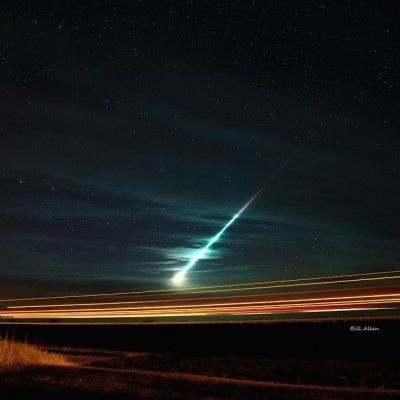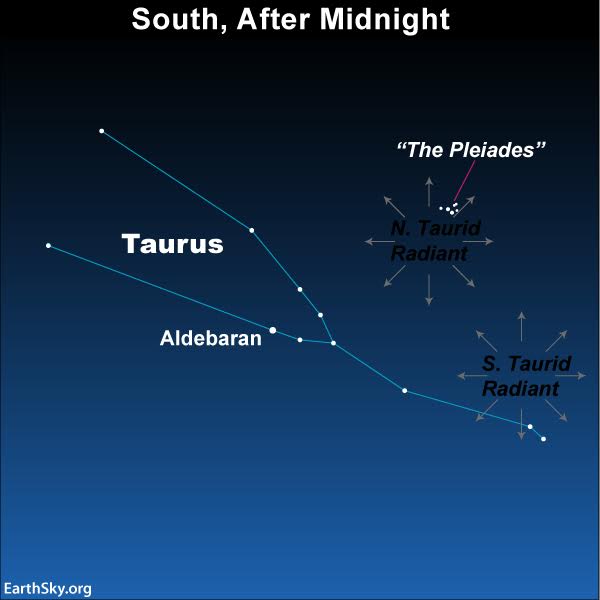

A cool shot of a Taurid fireball from November 11, 2015, by Bill Allen. Thanks, Bill! By all reports, this shower was amazing in 2015.
For the most part, we count on the Observer’s Handbook to provide us with the peak dates for the year’s major meteor showers. The Observer’s Handbook 2020 lists November 5 (06:00 Universal Time) as the peak time for the 2020 South Taurid meteor shower. We find this prediction re-echoed in Sky & Telescope magazine’s Skygazer’s Almanac 2020 as well as other publications.
Yet two other trusted sources give a different date for the South Taurid peak. The International Meteor Organization (IMO) says the night of October 10. The American Meteor Society (AMS) gives the night of October 29-30, claiming that this shower:
… rarely produces more than five shower members per hour, even at maximum activity.
Astronomer Guy Ottewell, in his 2012 Astronomical Calendar, helps to explain the discrepancy for the peak date of the South Taurid meteor shower. He explained:
Fresh IMO evidence suggests the southern branch, rather than reaching its maximum in early November as long believed, actually has its peak in October instead.
Whenever this year’s peak may happen, it’s probably safe to assume that the long-lasting South Taurid meteor shower (September 10 to November 20) will display no sharp peak.

The Taurid meteors consist of two streams, the South Taurid and North Taurid meteors. Both streams appear to originate from the constellation Taurus the Bull.
These South Taurid meteors steadily amble along for weeks on end, rarely exhibiting any more than five meteors per hour! So the moon’s phase may play more of a role than the peak date. This year, in 2020, the last quarter moon obtrudes on the show on the night of October 9-10, whereas the moon will be nearly full on the night of October 29-30. The latter date – November 4-5 – has a bright waning gibbous moon.
But the new moon comes at mid-month in October and November 2020. So for about a week, centered at mid-month, you’ll have a dark sky for watching these meteors. If you’re a weekend warrior, the weekend starting on Friday, October 16, 2020, may be your best bet for watching the Taurid shower.
From what we have been able to gather, the Taurid meteor stream consists of an extremely wide roadway of far-flung debris left behind by Comet 2P/Encke. When Earth travels through this belt of comet debris, bits and pieces of Comet 2P/Encke smash into the Earth’s upper atmosphere to vaporize as rather slow-moving Taurid meteors (28 km/17 miles per second).
Yet, the Taurids are known for having a high percentage of fireballs.
Apparently, the original Taurid stream had been perturbed by Jupiter into two branches: South and North Taurids. The South Taurids, the more prominent of the two, are active from about September 10 to November 20, whereas the North Taurids are active from about October 20 to December 10.

View larger. | South Taurid meteor. Note the Pleiades star cluster above the meteor, and the bright star Aldebaran roughly midway between the Pleiades and the meteor. Image via Flickr user Rocky Raybell.
Peak dates aside, meteor aficionados will be on the lookout as the South and North Taurids simultaneously produce meteors in late October and early November. Higher rates of Taurid fireballs might happen in seven-year cycles, and the last grand fireball display was in 2015.
In short, the Taurid meteors might produce a “swarm” of fireballs in late October and early November, regardless of which date the South Taurid meteor shower peaks!
Bottom line: It’s meteor season! This shower rarely produces more than five meteors per hour (although it’s been known to produce a high percentage of fireballs). Now … when do the South Taurids peak, October or November?
from EarthSky https://ift.tt/30Tt4gc


A cool shot of a Taurid fireball from November 11, 2015, by Bill Allen. Thanks, Bill! By all reports, this shower was amazing in 2015.
For the most part, we count on the Observer’s Handbook to provide us with the peak dates for the year’s major meteor showers. The Observer’s Handbook 2020 lists November 5 (06:00 Universal Time) as the peak time for the 2020 South Taurid meteor shower. We find this prediction re-echoed in Sky & Telescope magazine’s Skygazer’s Almanac 2020 as well as other publications.
Yet two other trusted sources give a different date for the South Taurid peak. The International Meteor Organization (IMO) says the night of October 10. The American Meteor Society (AMS) gives the night of October 29-30, claiming that this shower:
… rarely produces more than five shower members per hour, even at maximum activity.
Astronomer Guy Ottewell, in his 2012 Astronomical Calendar, helps to explain the discrepancy for the peak date of the South Taurid meteor shower. He explained:
Fresh IMO evidence suggests the southern branch, rather than reaching its maximum in early November as long believed, actually has its peak in October instead.
Whenever this year’s peak may happen, it’s probably safe to assume that the long-lasting South Taurid meteor shower (September 10 to November 20) will display no sharp peak.

The Taurid meteors consist of two streams, the South Taurid and North Taurid meteors. Both streams appear to originate from the constellation Taurus the Bull.
These South Taurid meteors steadily amble along for weeks on end, rarely exhibiting any more than five meteors per hour! So the moon’s phase may play more of a role than the peak date. This year, in 2020, the last quarter moon obtrudes on the show on the night of October 9-10, whereas the moon will be nearly full on the night of October 29-30. The latter date – November 4-5 – has a bright waning gibbous moon.
But the new moon comes at mid-month in October and November 2020. So for about a week, centered at mid-month, you’ll have a dark sky for watching these meteors. If you’re a weekend warrior, the weekend starting on Friday, October 16, 2020, may be your best bet for watching the Taurid shower.
From what we have been able to gather, the Taurid meteor stream consists of an extremely wide roadway of far-flung debris left behind by Comet 2P/Encke. When Earth travels through this belt of comet debris, bits and pieces of Comet 2P/Encke smash into the Earth’s upper atmosphere to vaporize as rather slow-moving Taurid meteors (28 km/17 miles per second).
Yet, the Taurids are known for having a high percentage of fireballs.
Apparently, the original Taurid stream had been perturbed by Jupiter into two branches: South and North Taurids. The South Taurids, the more prominent of the two, are active from about September 10 to November 20, whereas the North Taurids are active from about October 20 to December 10.

View larger. | South Taurid meteor. Note the Pleiades star cluster above the meteor, and the bright star Aldebaran roughly midway between the Pleiades and the meteor. Image via Flickr user Rocky Raybell.
Peak dates aside, meteor aficionados will be on the lookout as the South and North Taurids simultaneously produce meteors in late October and early November. Higher rates of Taurid fireballs might happen in seven-year cycles, and the last grand fireball display was in 2015.
In short, the Taurid meteors might produce a “swarm” of fireballs in late October and early November, regardless of which date the South Taurid meteor shower peaks!
Bottom line: It’s meteor season! This shower rarely produces more than five meteors per hour (although it’s been known to produce a high percentage of fireballs). Now … when do the South Taurids peak, October or November?
from EarthSky https://ift.tt/30Tt4gc

Aucun commentaire:
Enregistrer un commentaire